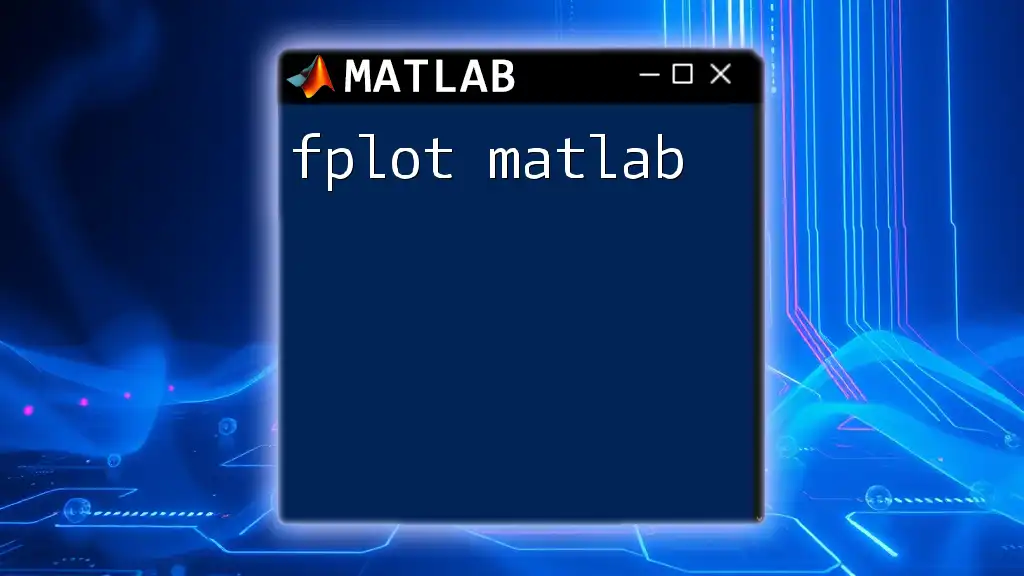The `filt` command in MATLAB is used for applying filters to signals, enabling engineers and researchers to manipulate and analyze data efficiently.
% Example of using the 'filtfilt' function for zero-phase filtering
b = [1, -1]; % Filter coefficients
a = 1; % Denominator coefficients
signal_filtered = filtfilt(b, a, original_signal); % Apply filter to the original signal
Understanding Filters in MATLAB
Types of Filters
FIR Filters (Finite Impulse Response) are characterized by a finite duration impulse response. This means that the output depends only on a limited number of past input samples. The advantages of FIR filters include:
- Stability: Always stable due to their non-recursive nature.
- Phase Linearity: Can be designed to have a linear phase, preserving the wave shape of filtered signals.
However, FIR filters can require a higher order to meet performance specifications, which can lead to increased computational load.
IIR Filters (Infinite Impulse Response), on the other hand, have an impulse response that theoretically lasts forever. Their output depends on both past input and output samples. The benefits of using IIR filters include:
- Efficiency: Typically require a lower order to achieve similar performance compared to FIR filters, leading to less computational complexity.
- Feedback Mechanism: Allows for more versatile filter designs.
Nonetheless, IIR filters can be more challenging to design and may introduce phase distortion.
Designing Filters with MATLAB
Filter design in MATLAB relies on several concepts and parameters, such as cutoff frequency, filter order, and the type of response (low-pass, high-pass, band-pass, etc.).
Common functions used in filter design include:
- `fdesign`: Used for filter design specifications.
- `design`: Executes the design based on specifications.
- `fir1`: Designs a linear phase FIR filter.
- `butter`: Designs a Butterworth filter, which is a popular type of IIR filter.

Using Filt in MATLAB
Basic Commands and Syntax
Using the `filt` function in MATLAB involves a straightforward command structure. The basic syntax is as follows:
y = filter(b, a, x)
In this context:
- `b` represents the numerator coefficients of the filter.
- `a` represents the denominator coefficients.
- `x` is the input signal.
- `y` is the resulting filtered signal.
As a practical example, consider the following MATLAB code snippet that applies a simple filter:
b = [0.2 0.2]; % Numerator coefficients
a = [1]; % Denominator coefficients
x = randn(100, 1); % Random input signal
y = filter(b, a, x); % Applying the filter
This example initializes a simple random signal and applies a basic filter to it.
Filtering a Signal
To filter a more complex signal, such as a sinusoidal signal corrupted with noise, follow these steps:
- Generate a noisy signal.
- Design a filter.
- Apply the filter using the `filter` function.
Here's a code snippet illustrating this approach:
Fs = 500; % Sampling frequency
t = 0:1/Fs:1; % Time vector
x = sin(2*pi*50*t) + randn(size(t)); % Signal with added noise
% Design a low-pass FIR filter
b = fir1(20, 0.1);
% Apply the filter
y = filter(b, 1, x);
In this example, a low-pass FIR filter is designed and used to clean up a noisy sine wave.
Advanced Filt Usage
For more sophisticated applications, multi-channel filtering can be crucial, especially in audio and image processing. MATLAB's filtering capabilities can equally handle multiple channels, enabling the application of the same filter across different data streams.

Real-world Examples
Example 1: Removing Noise from a Signal
Removing noise from a signal is a common task in data analysis. Consider the code snippet:
Fs = 500; % Sampling frequency
t = 0:1/Fs:1; % Time vector
x = sin(2*pi*50*t) + randn(size(t)); % Noisy sine wave
% Design a low-pass FIR filter
b = fir1(20, 0.1);
% Filter the signal
y = filter(b, 1, x);
% Visualize Results
subplot(2,1,1);
plot(t, x);
title('Original Signal');
xlabel('Time (s)');
ylabel('Amplitude');
subplot(2,1,2);
plot(t, y);
title('Filtered Signal');
xlabel('Time (s)');
ylabel('Amplitude');
This example demonstrates how to eliminate high-frequency noise from a sine wave, allowing for clearer analysis of the underlying signal.
Example 2: Digital Audio Processing
In digital audio processing, filtering can enhance sound quality by removing unwanted components. Applying a filter to an audio signal involves the same principles as above but requires attention to factors such as sample rates and filter types to avoid artifacts in sound quality.

Visualization of Filtered Data
Plotting Data in MATLAB
Visualizing filtered data in MATLAB is essential for understanding the impact of filtering. Two commonly used commands for plotting are `plot` for time domain representations and `stem` for discrete signals. The `freqz` command can be employed to visualize the frequency response of the designed filter.
Example Visualization
To visualize results effectively, employ the following code snippet:
subplot(2,1,1);
plot(t, x);
title('Original Signal');
xlabel('Time (s)');
ylabel('Amplitude');
subplot(2,1,2);
plot(t, y);
title('Filtered Signal');
xlabel('Time (s)');
ylabel('Amplitude');
This will show the original and filtered signals in a subplot format, allowing for easy comparison.

Troubleshooting Common Issues with Filt in MATLAB
Common Errors and Solutions
When using the `filt matlab` approach, you might encounter errors related to filter coefficients and signal dimensions. A common issue is misunderstood filter coefficients, which can lead to unintended filtering effects. Always ensure coefficients are derived from the correct filter design and problem context.
Another frequent issue is signal length mismatch, where the output length does not align with expectations. This can often occur if the input signal is incorrectly defined. Double-check that the input signal’s dimensions are compatible with the filter design.
Tips for Optimization
For large datasets or complex filtering tasks, consider optimizing your filtering process. Reducing filter order where possible or using efficient implementations can lead to significant improvements in processing time without sacrificing quality.

Conclusion
In summary, understanding how to use filt in MATLAB is crucial for anyone looking to engage deeply with data analysis, especially in fields requiring signal processing. As covered in this guide, mastering filter design, implementation, and visualization will substantially enhance your capability to manipulate and analyze complex data.
Additional Resources
To further deepen your understanding, I recommend consulting the official MATLAB documentation as well as participating in community forums where experienced MATLAB users share insights and solutions. Engaging with these resources can provide nuanced knowledge and practical techniques that extend beyond the basics discussed here.

















